#2020 coronavirus challenge
Photo
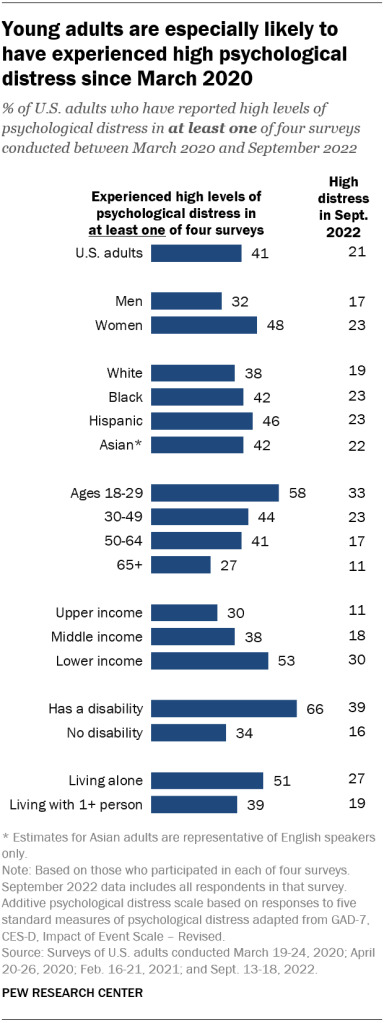
The coronavirus pandemic has been associated with worsening mental health among people in the United States and around the world. Three years later, Americans have largely returned to normal activities, but challenges with mental health remain.
41% of U.S. adults have experienced high levels of psychological distress at some point during the pandemic, according to four surveys conducted between March 2020 and September 2022.
Young adults are especially likely to have faced high levels of psychological distress since the COVID-19 outbreak began: 58% of Americans ages 18 to 29 fall into this category, based on their answers in at least one of these four surveys.
Read more: Mental health and the pandemic: What U.S. surveys have found
168 notes
·
View notes
Text
Aoi Honoo IV - Prologue (the introduction)
Disclaimer: Full translation of AH4's Prologue done via machine translation (ChatGPT, Google Translate, DeepL and several other obscure online dictionaries). This means: nuances may be lost, meanings may be vague/muddled, but the relevant information is present. (@/LiaRyFS)
In 2019-2020, Hanyu Yuzuru thought about various things and hesitated, but ultimately he strongly decided to jump the quad Axel. Looking back on that season, he said as follows.
“2019 was a year of constant battle for me, including the World Championships in Saitama in March. I had been practising the quad Axel for a while, but it didn't go well for a long time… Sometimes I could jump it when I practised with a harness, and I thought, 'If I could do more of this, I might be able to do it.' But I also got injured again while trying things out, and there were many things that happened that season.
It was a year in which I kept challenging myself, but it was also a year in which I felt a sense of defeat as if everything had been broken. It's like there's nothing I can do on my own power, and that's how it felt…
At the Torino Grand Prix Final, of course, I felt that even if I made a lot of effort, I couldn't win without the support of the people around me. I somehow felt at that time that there is a world where no matter how much effort you put in, you can't win without the moment when everyone's power comes together, like at the Olympics.
However, it was a bit different from the statement made at the 2022 Beijing Olympics that 'effort will not be rewarded'. At that time, I think my desire to 'just get better' was still strong, so I was expressing those kinds of thoughts. As the consecutive competitions went on, I lost the strength to say such things when I lost at the All Japan Championships. 2019 was a year in which I struggled, not wanting to just be someone who won two consecutive Olympic titles, or someone from the past.”
When the new year began, he tried to find his way out of that despair.
“Since 2020, I have tested myself and thought a lot about what figure skating really means. So with the desire to regain my confidence, I returned to skating to my programs, ‘Ballade No. 1 in G minor’ (hereinafter referred to as ‘Ballade No. 1’) and ‘SEIMEI’. Since I had not yet won first place in the Four Continents Championships, there was a similar feeling of joy to my first victory in the 2019 GP Skate Canada. (N/T: Winning Skate Canada and 4CC sparked similar feelings of joy) I was really happy to have won! I think it was a big deal that Nathan Chen didn't participate at that time, but still winning the Four Continents for the first time and being able to win all the competitions that I had left behind gave me a sense of achievement and I was enveloped in a great sense of accomplishment.
However, what was bothering me inside was still the quadruple Axel. Even if I skated 'Ballade No.1' more beautifully than before and improved technically, there was a sense of resignation that 'I can't get a score higher than 2015' or something like that. The competition was the one where I felt like I had finally let go of my doubts and decided to focus solely on attempting the quadruple Axel. In a sense, that season was when I was able to establish a clear path towards expressing myself through the program and the 4A.”
However, his feelings were complex towards the World Championships that were coming up next (N/T: WC2020)
“In retrospect, I feel like I wasn't as fully invested in preparing for the World Championships as I thought I was, although at the time I was putting in my best effort. Unfortunately, it was ultimately cancelled due to the impact of the coronavirus. Winning the Four Continents Championship was a very fulfilling achievement, and I don't think it's normal to experience burnout after winning Four Continents, but in a way, there was a sense of resignation and a lifting of the confusion in my heart, combined with the fact that I was going to compete against Nathan, so... to be honest, that World Championships wasn't a competition where I had to jump the quadruple Axel, and the quadruple Axel wasn't a jump I could do even after practising it for about two weeks.
Since the program with the quad Lutz, 'SEIMEI,' had a different composition, I aimed to stabilise that first, and also, I had already peaked a little since the Four Continents, so honestly, during that short period, I couldn't do much except to adjust to get back to my peak.
However, at that time, the fear of competing against Nathan had already disappeared. It's like, 'I don't mind losing anymore' (laughs). In a way, until the cancellation of the World Championships, I always thought that it would be enough for me to firmly express what I wanted to express and to firmly follow the path of figure skating that I believed in.
However, when the World Championships were actually cancelled, I cried a lot. I couldn't help but wonder, ‘What was I working so hard for?’ And when it was actually cancelled, I realised that I hated going into competitions with the mind-set of 'losing'.”
From there, the spread of the novel coronavirus increased and the situation became such that people were unable to move around freely.
“In the end, that was the end of the 2019-2020 season, and after that, the spread of the coronavirus began, but I didn't have much hope. I was devastated at the 2019 GP Final and All-Japan, and had given up after ‘Ballade No. 1’ at the 2020 Four Continents Championships. From that time on, I didn't have much hope while practising. Rather, the only goal was ‘to jump the quadruple Axel!’
Even if my skating skills and other things improve, it doesn’t mean that the program components score will grow any further. Even if I perfected the expression through music, even if I matched the sound of the jumps to the sound of the music. Even if I did jumps with more variations from difficult steps, the GOE will not improve significantly. Rather, because of that, the speed would be slower and the height of the jumps lower, so some judges give 0 or +1 GOE.
In that sense, I felt like ‘I don't really care about those things anymore’ and decided to be true to myself. Although it may sound like an excuse, rather than trying to do something while decorating myself as 'Yuzuru Hanyu', I think I started practising with the feeling of facing my own core and jumping the quadruple Axel, thinking ‘I'm going to finish this’. So, when I came back to Japan, I started training with that mind-set.
To be honest, there were times when I felt really hopeless, and when the World Championships were cancelled, I cried with relief thinking, ‘I'm glad I don't have to go to a losing match’. In reality, I hadn't been able to push myself to the limit and I wasn't able to perform as well as I wanted to.”
Challenging himself alone in Japan after returning home was even more difficult than he had imagined. Later, Hanyu talked about that time.
“In those days, I felt like I spent a lot of time having a dialogue with myself and facing skating. The desire to successfully perform a quad axel was always at the core of my being. After the Pyeongchang Olympics, I had absolutely no motivation, so if I didn't have the quad Axel, I think I would have definitely quit, and I would have thought about retiring earlier. But thanks to that, I think I now have a reason to live pursuing my dreams, and that is the centre of my current life. I think that hasn't changed from those days to now.
However, at that time, there were challenges in pursuing the quad Axel jump. There were times when the gears didn't quite mesh due to factors such as not having a coach to guide me, changes in practice environment, and issues with body care that I had to decide on my own. At that time, I had a feeling that not only my 4A but also the level of what I was doing was gradually decreasing. I had a feeling like, 'Why am I even doing figure skating?'...It was like a sense of loss. It's like my own abilities were diminishing, or like my skating wasn't my own anymore. I felt a strong sense of sadness, like seeing my ideals getting further and further away from me. When I perform in ice shows or when I have my coach watch me skate, I receive feedback like 'this was good' or 'let's try this a little differently' but when I set such a high goal for myself like attempting the quad Axel alone, I have to spend every day unable to achieve it. I was doing it without any self-affirmation in the midst of that.”
In addition, he completed his graduation thesis for the correspondence course of the Waseda University Faculty of Human Sciences at the end of July, but the burden of collecting data for it was also significant.
“That required a lot of energy. What was published in academic journals was really just a small part, and we actually collected much more data and did various things. It took time to collect that data and required a lot of mental effort as well. At that time, various things coincided. My foot hurt from practising the quadruple Axel, and I had to rest from practice. When I returned to practice, I couldn't jump at all... Everything was already leaning in a negative direction.”
The cancellation of the ice show that used to be held every year, due to the spread of the new coronavirus infection, was also a loss for Hanyu, who had always continued to challenge himself with a forward-looking attitude.
“To be honest, there was a time when I didn't understand why I loved skating. If we really, really go back to the origin, it was something like an extraordinary feeling. The sensation on the ice is completely different from the sensation of living on the ground, isn't it? Because it's such a difficult thing, I think there was a sense of joy when I was able to do it. And then, skating alone on that wide rink and everyone watching only me. If my performance was good, I would receive tremendous cheers, but if it was bad, I would only get mediocre feedback.
I think that sensation of being watched, of being seen, is something that I really liked. But as I continued skating for a long time, that feeling gradually faded away, or became commonplace. In addition to that, there was also a lot of pressure to meet everyone's expectations, and it became not just fun, but also nerve-wracking, worrying about what would happen if I failed, and so on. It was because of the accumulation of those things, and the increasing burden that came with it, that it stopped being enjoyable, or rather, there was no time to think about enjoying it anymore.
I feel a lot of pressure to 'perform well’ even at ice shows, so I practise a lot for that purpose. So, I think that's why, during the off-season when I wasn't in front of everyone, I started to feel even more like 'why did I love skating again?'”
In the midst of feeling cornered, he had to think and make various decisions on his own. And he had to keep challenging himself with the high hurdle of the quadruple Axel.
“There were times when things didn't go well, and that's why at that time, my mind and my head were in a mess and I felt like I couldn't do anything. Normally, if I played a game or something, it would refresh me and I would think ‘Alright, let's do our best next time,’ but at that time, there was nothing I could do.
Experiencing the pain of practising alone to the point of hating it, Hanyu decided to withdraw from the Grand Prix series during that period. The Grand Prix series of this year was held in a modified format due to travel restrictions between countries. Each skater was allowed to participate in only one event, and the conditions for participation included skaters, judges, and officials from the host country, as well as skaters who regularly practised in the host country. In addition, only skaters from other countries who were invited based on their geographical location were able to participate.
Afterwards, the second event Skate Canada and the fourth event in France were cancelled, and only the first event Skate America, the third event in China, the fifth event in Russia, and the sixth event NHK Trophy were held. The Final was also announced to be cancelled.
In August, Hanyu took into consideration that "many people would have to travel due to my participation".
He announced his withdrawal, saying, "If I refrain from going and make efforts to prevent the spread of infection, I believe it can be one of the activities to prevent the spread of infection." For Hanyu, who has used going to competitions as a way to stimulate his emotions and as a source of energy for his evolution, it was a difficult decision.
107 notes
·
View notes
Text
Published Sept 30, 2023
Abstract
Objective: Besides its morbidity and mortality all over the world, SARS-CoV-2 infection maintains its importance with prolonged symptoms after acute disease. The post-infectious period including a heterogeneous group of symptoms is named ‘long COVID’. This study aimed to describe persisting symptoms three months after COVID-19 and risk factors associated with ‘long COVID’.
Materials and Methods: This cross-sectional retrospective study included COVID-19 patients diagnosed with SARS-CoV-2 PCR positivity in the first 18 months of the COVID-19 pandemic, between March 2020 and September 2021. We conducted a survey in 2022 to inquire about the participants’ symptoms that lasted three months or more after their own COVID-19 period. All patients were employees of one of the biggest national banks in Turkey. Participants answered a total of 31 questions over the phone. The presence of one or more symptoms persisting ≥3 months was defined as ‘long COVID’. The risk factors associated with ‘long COVID’ were determined.
Results: A total of 1301 patients were included in our study. The median age of patients was 40 (22-57), and 558 (42.9%) were women. 257 (19.8%) patients had ‘long COVID’ symptoms. The most prevalent symptoms were myalgia (14.3%), arthralgia (14.1%), and back pain (13.8%). Female gender (p=0.000, OR=2.19 [95% CI=1.655-2.904]) and diabetes mellitus (p=0.016, OR=2.43 [95% CI=1.177-5.017]) were found as independent risk factors for ‘long COVID’ by multivariant logistic regression analysis.
Conclusion: Female gender and diabetes mellitus are risk factors for ‘long COVID’. Detecting patients with a high risk for developing ‘long COVID’ is crucial for their management during the COVID and post-COVID periods.
#mask up#covid#covid 19#covid isn't over#pandemic#covid conscious#long covid#covid is airborne#wear a mask#coronavirus
5 notes
·
View notes
Text
Even liberal San Francisco voters are getting tough on crime and public disorder.
Residents of the City by the Bay approved ballot measures Tuesday to set minimum police staffing levels, allow officers to chase suspects under reasonable suspicion they have committed or will commit a felony or nonviolent misdemeanor — with the help of drones — and set up public safety cameras that could use facial recognition technology to apprehend perps.
Another proposition that passed requires anyone who receives employment assistance, housing, shelter, utilities or food from city coffers to submit to drug screenings — and denies them those benefits unless they enter a treatment program.
The San Francisco Police Department had prohibited officers from pursuing nonviolent offenders unless there was an imminent risk to public safety.
Mayor London Breed, a Democrat, backed the ballot measures as she eyes re-election to a second full term in November — while facing challenges from Daniel Lurie, a nonprofit executive, and current and former city officials including ex-interim mayor Mark Farrell.
“We want San Francisco to be exactly what the people who live here want to see,” Breed said at a cocktail bar surrounded by supporters as the results rolled in Tuesday night, according to Politico. “And that is a safe, affordable place to call home.”
Voters also overwhelmingly approved tighter ethics rules for city employees regarding the receipt of gifts and mandating the teaching of Algebra I in schools by eighth grade.
Ballot measures allow voters to directly change laws during elections without the help of their elected officials.
Following a spate of state and local changes to crime policies in recent, San Francisco has been dogged by retail crime sprees, burglaries, rampant open-air drug use and public defecation.
Florida Gov. Ron DeSantis, during a high-profile TV debate this past November against former San Francisco Mayor and current California Gov. Gavin Newsom, pointed to the city’s downfall as proof of failed liberal policies.
Dozens of big-name businesses have departed the city’s formerly bustling downtown area since 2020, the year after Breed was elected. Drug overdose deaths also hit a record high last year, with 806 recorded.
The descent into lawlessness was turbocharged by the COVID-19 pandemic and widespread rioting following the killing of George Floyd by Minneapolis police in summer 2020, as San Francisco and other cities embraced calls to defund law enforcement.
Breed supported a $120 million cut from the city’s police budget in 2020 — but reversed course the following year and pleaded with the San Francisco Board of Supervisors to restore funding.
“I’m proud this city believes in giving people second chances,” she said in December 2021. “Nevertheless, we also need there to be accountability when someone does break the law … Our compassion cannot be mistaken for weakness or indifference … I was raised by my grandmother to believe in ‘tough love,’ in keeping your house in order, and we need that, now more than ever.”
The pivot to the center came just in time, as disgruntled San Francisco voters went on the following year to recall District Attorney Chesa Boudin, a progressive prosecutor and former public defender.
Before that, parents had ousted three members of the city’s school board for pushing a progressive political agenda and keeping classrooms closed during the coronavirus pandemic.
A former city supervisor, Breed was elected mayor in 2018 to finish out the term of the late Ed Lee, who died in office. She was later elected to a five-year term in November 2019.
She is still working to regain the trust of law enforcement officials, however, with the San Francisco Deputy Sheriffs’ Association saying in November that her “commitment to dismantling the criminal justice system has remained a focal point.”
Breed is battling a high disapproval rating, with 71% of likely general election voters taking exception to her job performance, according to a San Francisco Chronicle poll last month.
The city’s ranked-choice voting system could also throw a wrench into Breed’s re-election bid if she does not receive at least 50% support in the initial round, as second- and third-place candidates often receive more votes than those at the top of the ticket.
6 notes
·
View notes
Text
GQ Japan Interview: Mackenyu Arata x HUBLOT
(05/12/2022)
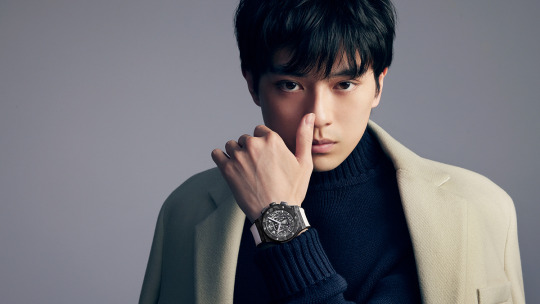
“Right now I am having the most fun and at my happiest. I’m living my dream,” Mackenyu Arata, a man who continues to challenge himself.

"If the world around you doesn't change, then it's better to change yourself," actor Mackenyu Arata who left Japan with that mindset, resonates with HUBLOT, a brand that continues to challenge. What kind of scenery does the 26-year-old who had challenged the world see now?
“I’m the kind of person who doesn’t mind eating curry every day,” Mackenyu said of himself. He doesn't have a lot of material desires, and says that as long as he likes something, that's enough. The watch he has been using for the past two years is the Hublot Classic Fusion Black Magic.
"It's the first watch that I thought was cool and I wanted it. It's not really flashy or big, it's elegant but it has a presence. My father was always wearing a watch, so growing up, I thought it was natural to wear a wristwatch. I always wear it when I'm not working as my 'buddy' I spend my precious time with."
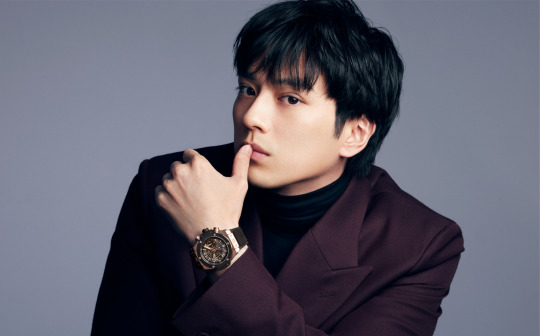
In 2020 Mackenyu decided to be active overseas. He had been challenging the world a year later.
"The impact of the coronavirus was a big factor in giving me time to think for myself. Since my teenage years my work schedule has always been packed, so I didn't really have time to reflect on myself. I would be filming a movie in the morning, and a drama series in the afternoon. At the same time I would also attend interviews for publicity. I was living a life where I could only sleep on the move. During the pandemic, I spent time with my family and friends, and also with myself. As I engage in my hobbies, I realized that I enjoy this kind of time, and I think its important to have them. Up until that point I've always had this anxiety, that if I'm not constantly working, I would disappear. But really there's no need to feel that way. That time made me think that I want to enjoy myself more, both at work and in life. I reflected on this and it had influenced me in the way I work and how I make decisions. I've realized that I should be doing what I want to do and just do what I want to do."
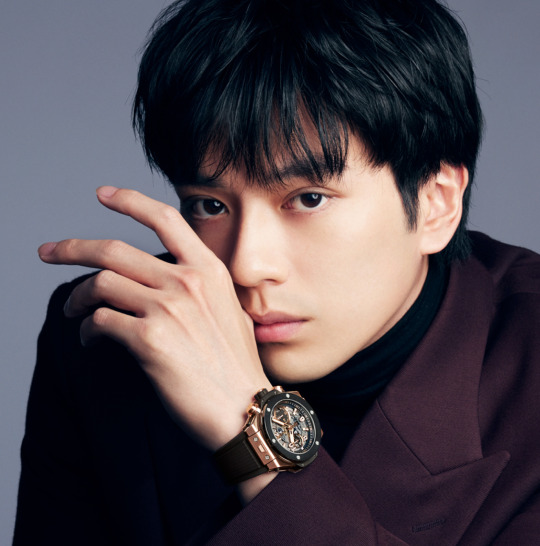
Born and raised in the US, he has the "weapon" of English. Temporarily stopping his activities in Japan to challenge himself overseas, what awaits him were the Hollywood's adaptation of Saint Seiya "Knights of the Zodiac" and the Netflix series "One Piece" (both scheduled to be released in 2023).
"I wonder if I was scared when I accepted the role back then... I don't remember (laughs). Anyway, working abroad was fun. The scale of the work is different from Japan. A huge number of people risk their lives to make a series with a budget that is 100 times bigger than that in Japan, and the degree of their commitment is just incredible. I'm already happy just being there among those people. Moreover, the working environment is set in order, the cast and staff have time to rest properly. So when work begins, everyone is in good spirit and they work wholeheartedly. To be honest, this is completely different than in Japan. In Japan, even when I take care of my health properly, it wasn't easy to get rid of my fatigues from work. But I'm really healthy now though (laughs). I realized that there's a world where I can be an actor under those circumstances."
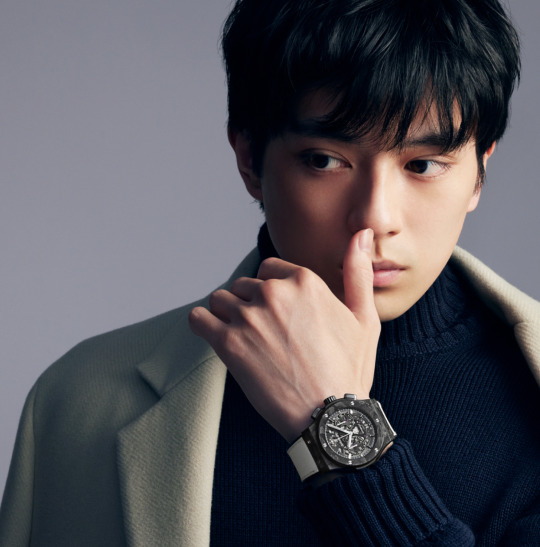
In Knights of the Zodiac, he was chosen as the lead. His overseas career took off with a smooth start.
"It feels like I'm living my dream. Right now I am having the most fun and at my happiest. I had the opportunity to check the finished movie footage. I was taken aback. When a team of first class professionals work together, we can achieve this quality. I couldn't be any happier to be the lead in this movie. I can't wait to see the final movie, and I'd like everyone to watch it too. I'd like people to feel inspired when they see me in that movie. That I represent Japan, and challenge the world as a Japanese actor. I don't plan to convey big messages like encouraging people to revitalize Japan or anything, but if we could break out of our shells and jump out of it, there's this incredible world that awaits you. To instill that kind of mindset alone already makes me happy."
Source: https://www.gqjapan.jp/feature/20221205/hublot-mackenyu-arata
#interviews#mackenyu arata#mackenyu#knights of the zodiac#one piece live action#OPLA#KOTZ LA#saint seiya#roronoa zoro#pegasus seiya
54 notes
·
View notes
Text
Review: Louis Tomlinson’s ‘All Of Those Voices’ shares a heartfelt story of growth
DAILY TROJAN
By JESSICA MESSINA | March 26, 2023

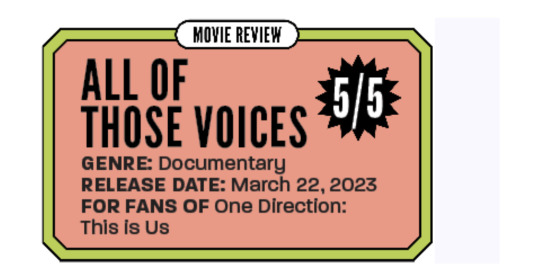
In an intimate look at his life and career, audiences delve into an in-depth journey alongside Louis Tomlinson as he forges his path through the last 13 years in the documentary “All of Those Voices,” released March 22. In the film, director Charlie Lightening brings to life a raw and emotional story of self-discovery.
The documentary travels back in time to the moment where it all began: “The X Factor.” From Tomlinson’s audition to the formation of his band — One Direction — and its snowballing success, life as he knew it would never quite be the same again. Rather than glossing over reality, Tomlinson was forthright about his struggles to find his footing in the band and the lack of control he felt during its first few years. He shared that he is most proud of contributing more writing credits than anyone else in the band, finding a way to leave a creative mark on One Direction’s legacy.
The band’s breakup is seen as a jumping off point for Tomlinson’s introspection as an artist and individual outside of the group. Just as he started to figure out his place, tragedy struck. His mother, Johanna Deakin, passed away in 2016 after battling leukemia. The film explores the deep bond Tomlinson shared with his mom, mostly on account of his father’s absence and the fact that his mother had him at only 19.
Tomlinson was scheduled to play a show on “The X Factor” the same week of her passing, and in a present-day testimony, he discusses the challenge of performing with such loss — yet the motivation he still garnered from his mother — even after death. Three years later, his sister Félicité passed, further demonstrating the hardships he faced outside of being an artist and the willpower it took to continue his work.
While most artists shield their personal lives from the public, Tomlinson’s brutal honesty in the documentary displays the trust he holds with his fans and his desire to be understood as their equal. The personal deep-dive into his life is unlike most other artist’s documentaries in that it establishes a deep bond with the audience. Rather than seeking to just to be taken seriously, he utilizes the film to display a sort of humanity we rarely see in artists, especially those who we often put on a pedestal.
With a trail of lows, the highs in his career felt that much more satisfying. In 2020, Tomlinson released his debut album “Walls.” Upon the album’s release and start of the tour, Tomlinson described how he could feel himself beginning an upward trajectory. Performing live had always been his favorite part of One Direction and having the opportunity to do it again solo provided him with the sense of purpose he lost after the band’s end.
But he just couldn’t yet win, as the coronavirus pandemic hit, forcing him to reschedule his tour for two years later. Tomlinson recounted using the lockdown period to find his voice musically and, more importantly, take a well-needed break with family.
Tomlinson’s experience during the abrupt halt of the coronavirus lockdown was easy to relate to. Tomlinson reminded the audience, yet again, that while he may be a music artist, he shared the same struggles and newfound opportunities as everyone else.
In 2016, Tomlinson’s son, Freddie, was born. He now lives in Los Angeles with Freddie’s mother, whereas the rest of Tomlinson’s family reside in his hometown of Doncaster, England. Tomlinson discusses how having a career that demands travel has been emotionally taxing, as he is forced to spend his time away from his loved ones. While many aspects of Tomlinson’s life are public, he largely shielded his role as a father from the media. The immersive look at his relationship with Freddie was a sentimental touch to the film, and one that expanded on his persona as an individual outside of his former band.
Despite his heartache toward his complicated and troubled career path, Tomlinson used the film to display his love for his family. As the oldest brother to all sisters, his siblings gave personal accounts of him being their fiercest and most loyal protector, especially after their mother’s passing. His grandparents displayed their admiration for his strength and spoke on the special bond he had with his siblings. Displaying such personal aspects of Louis’ life breaks down some of the facades around celebrity culture to remind the audience that, just like them, he has people who he cares for wholeheartedly.
In a scene that touched the hearts of all audience members, the film included footage from the first live show Freddie ever saw his dad perform. Becoming vulnerable and even heavily crying in front of the camera, Tomlinson spoke on the importance of that moment in their relationship.
Once the coronavirus lockdown was over and Tomlinson restarted his tour, he began to gain momentum once again. Tomlinson noted that his relationship with the fans had always been special to him, especially seen in the energy during live shows. In a standout quote, he claimed, “I need you and you need me.” This sort of symbiotic relationship he holds with his fans speaks to not only their faith in him, but his growing faith in himself seen throughout the duration of the film.
By the end of “All Of Those Voices,” Tomlinson completed his first world tour and his second album. In a way, the documentary proved that though Tomlinson’s value has been historically undermined and, even against all odds, he continues to rise above. His lighthearted charisma and desire for authenticity shined through the work. Whether you walk into the theater a Louis Tomlinson fan or not, it is hard not to leave one.
“I deserve this,” said Tomlinson for the first time aloud at the conclusion of the film.
And if “All Of Those Voices” proves anything, it’s that he absolutely does.
35 notes
·
View notes
Text
The Extra || Austin Butler x OC
Chapter Eight

Pairing: Austin Butler x OC
Warnings: mentions of past innuendo, mentions of sex, nightmares.
Word Count: 2824
>> hellooo welcome to chapter eight! I know I keep leaving you all with cliffhangers but this chapter is pretty tame. please let me know if you enjoy it! (:
Series Masterlist | Main Masterlist | Add yourself to the taglist HERE
March 2020
I have been holed up in an apartment for weeks without being able to leave. I’ve been stuck in a relationship where I wasn’t held to an acceptable standard. I have been through the wringer with my ex, trying to figure out how to get out of the tense situation without ruining our new friendship, if you’d call it that. I got through all of those things. But I had never felt so stuck before in my entire life until Austin told me that an entire movie, a person’s life story, and the hope of fans worldwide now fell on me. And I don’t know if that’s something I can get to the other side of. Apparently, I look enough like Priscilla to be her character and have enough acting experience. Besides, desperate times call for desperate measures, and if an extra has to be used in the main cast, it wouldn’t be the end of the world. But it felt like it was the end to me.
Baz decided that everything we have filmed so far will be refilmed after the six months are up. Not just because I was recast, but because he felt it would be better that way. I have to stay with Austin during these six months because I have to gain chemistry with him or instead gain chemistry back. Whatever we have going on right now isn’t a good kind of chemistry to work with, so we have to fix that. Also, I can’t really go home anyway. Everyone has been told that wherever you are right now, you should probably stay if possible. The virus has become too dangerous. I broke the lease to my apartment and had everything I brought with me here transferred to Austin’s condo, thanks to Tyler. He’s slightly upset that we can’t have movie nights anymore in each other’s apartments, but he understands completely. Jess is feeling better. Luckily, their coronavirus case wasn’t extreme, and they don’t have any long-term side effects.
Dacre and I are still friends; we’ve actually grown closer since quarantine. Sometimes it makes Austin feel weird, but he isn’t as jealous as he used to be. Luke and Dacre forgave Austin for his unhinged comment. But they made sure to tell him that even though they were cool, they would physically harm him if he hurt me again. Tom checked up on us every other day until he and his wife got the virus. His case is really bad, and everyone is very worried about him. On the bright side, Olivia has gotten a little better and has been really supportive of me replacing her part. I still feel like I’m betraying her in a way, but she has assured me that I could absolutely do this- that I’m capable of playing Priscilla. Even Priscilla herself has reached out to me to tell me that based on what everyone has been telling her, she was pleased to “have a great woman” like me to play her. That alone was enough to wake me up. I need to play this part whether I like it or not. Whether I want to be famous or not.
It’s been a struggle for the last two weeks. I had to make sure to tell Austin that I wasn’t mad at him and I didn’t hate him. And that if I was distant, I just had a lot to think about. I had to think about how I would play a serious, life-changing role as an actress with little prior experience. I really, really had to think about how to go about living with Austin again now that we had to forcefully. I also had to think about our relationship, whether it was romantic or platonic. Our characters are romantically involved, so we have to work on our dynamic. We can’t fight anymore or let anything come between us while filming, or else it would be challenging to maintain chemistry. Apparently, there’s an on-screen kiss that we have to prepare for, too. I don’t know how ready for that Austin or I will be, but I guess we’ll cross that bridge when we get there.
I have decided to wait until Austin and I get out of this weird patch before thinking any harder about pursuing our relationship again. I don’t want the foundation of our rekindled relationship to be built on any hesitance or negative emotion. I told him I’d think about it, and I have, but I won’t think on it more than I have to until it’s necessary. Luckily, I think we’re beginning to move out of the awkward phase anyway. It shouldn’t be long before we’re entirely out of it.
It’s a Friday night, not that the day of the week matters anymore at this point, and Austin and I are on the couch. We’re watching our favorite show we used to binge when we were together, and for a moment, it almost seems like old times. Today was our last chill day before we needed to start working on our lines and execution. I plan on starting Priscilla’s book soon to gain more insight into her as a person. I’m not able to call her at any given time, much less see her in person, so at least I have some primary sources to gain perspective from. Austin has a plethora of sources for information on Elvis, so he has a lot to take from. I’ve been helping Austin practice maintaining his voice and accent when he wasn’t Zooming with a coach. My thoughts are interrupted when I notice what’s happening on the TV.
“I still can’t believe they killed him off like that,” I frown at one of my characters dying a painful death, even if it’s the tenth time I’ve watched the scene.
“Remember the first time we watched it happen? There’s nothing more painful than seeing it for the first time,” Austin shakes his head at the memory. We were both in hysterics the first time we watched this particular scene, to put it lightly.
“God, I know. It still hurts but not quite as bad,” I shrug, digging into the bag of hot chips I had on my side of the couch.
Austin eyeballs the bag for a moment before turning his eyes back to the TV screen, “You still eat those?” he asks.
“Yep. Sure do,” I say, popping a chip into my mouth.
“I don’t see how you have a stomach lining left,” Austin snorts as he chews on a Sour Patch Kid.
“I don’t see how you don’t have sores in your mouth,” I chide, motioning to the yellow bag of sour candy.
“Good point,” Austin shrugs.
His previously black-dyed hair is starting to fade into a weird shade of brown. He hasn’t bothered redying it since no one will see it. I thought the dark hair was a good look on him, in all honesty, but I’m partial to blonde-haired Austin. Especially when his hair was long and blonde. I would braid it sometimes when he’d let me.
“What are you thinking about?” Austin pipes up from next to me.
I shake my head, readjusting to real life after being deep in thought, “Nothing. Just thinking of old times.”
“Old times, huh?” Austin nods in acknowledgment, “How old?”
“As old as your long hair,” I giggle, almost wanting to reach out and touch the fading hair.
“I miss it sometimes,” Austin says, glancing over at me, “Especially when you’d braid it.”
“You only let me do that a few times, though. But I loved doing it,” I say with a smile.
“I never told you, but it felt really nice. I liked when you played with my hair,” Austin says, toying nervously with a Sour Patch Kid between his fingers.
“Trust me, I know. I know a lot of stuff you didn’t tell me,” I scoff, “Like when you’d secretly use some of my conditioner.”
Austin turns to me and looks a tad shocked, “How’d you know?”
“Austin, I could smell it on you. Did you think I wouldn’t know what my conditioner smells like?” I laugh, no longer paying full attention to the TV.
“Good point,” he sighs, and he looks as if he’s going to say something else but brushes it off.
“What?” I ask curiously.
“It’s nothing,” Austin swats his hand, “Just a silly question.”
“I love silly questions,” I narrow my eyes suspiciously at him.
“It’s kind of embarrassing,” he mumbles.
“Just tell me,” I roll my eyes, “You’re not one to keep something in if it’s bothering you.”
Austin looks at me and sighs because he knows I’m right. His face starts blushing a little as he figures out how to say whatever he’s going to say.
“I was gonna ask if you’d play with my hair. I know that’s weird,” he says defensively, “But it grounds me. And I’m too wired to sleep.”
My heart flutters a little at his sheepishness, “You could’ve just straight up asked me, Aus. I’m not gonna bite your head off.”
“I wouldn’t put it past you anymore,” Austin jokes.
“Whatever,” I shove his shoulder, patting my lap, “Lay down.”
He readjusts his sitting position to lay down properly before resting his head on my thighs. I almost instinctively reach my hand out to run it through his hair as if it hasn’t been a long time since I’ve done it. I guess it’s true that old habits die hard. Playing with Austin’s hair was the second thing he liked to do with me, the first being kissing. I see him letting me play with his hair as a step forward out of the fog we’ve been in. The kissing is obviously something he struggles with, but I’m not pushy. I took the hint when he didn’t kiss me when we had sex. Austin thought of kissing as being the most intimate thing a couple could share besides sex. He would do it any chance he got, even if it was in public. Austin couldn't get enough. Even if it’s such a sacred action for him, he didn’t waste time worrying about his surroundings or how PDA looked to others. It was as simple as holding hands and as intimate as sex. So, for now, running my fingers through his hair was enough for both of us.
Tonight would be the first night I would have a nightmare. In the nightmare, I’m plastered on every magazine and website, being labeled and scrutinized. It’s something I always made sure to stay away from in consciousness, but now I no longer could. The feeling of anxiety that I’ve been pushing down was beginning to present itself in my dreams. I make a lot of noise when I have nightmares and thrash around a lot, so when I’m awoken by a very concerned Austin, I’m not surprised. I’m more or so relieved that the nightmare is over than worried that he’s in my room.
“Are you okay?” Austin asks, out of breath from running in here to make sure I didn’t hurt myself by accident.
“Yeah,” I sit up, pressing my palm to my clammy forehead, “Just a bad dream is all.”
“You were yelling for a second, and I got worried,” Austin says quietly as he sits on the edge of the bed.
“Was I?” I furrow my eyebrows, trying to recall when I could’ve shouted, “Sorry.”
“It’s okay. Do you wanna talk about it?” Austin asks.
I shake my head, “No, it’s fine. Do you mind…” I trail off, wrapping my arms around myself. I try to figure out how to carefully word what I’m about to ask.
Austin misunderstands what I’m saying and gets up from the bed and heads to the door, but I blurt out my question before he can get one foot through the opening.
“Do you mind staying?” I blurt out, my face burning at my vulnerability.
It was hell the first time I had a nightmare after Austin and I split up. I couldn’t go back to sleep that night since I was so used to someone holding me until I relaxed. I had several nightmares about leaving Austin after we broke up, and every time was a struggle. I never really learned how to come down from the adrenaline by myself. I would stay awake until I had to be up the following day.
“Oh,” Austin mutters, “I don’t mind.”
I move over in the bed so he has enough room to slide in next to me. This is the first time Austin has held me since I left him. I wouldn’t consider his very brief period of having me on his chest after we had sex to be cuddling of any form. I’m a little nervous about having him so close to me without the sexual tension. It’s so intimate to have someone hold you and sleep next to you, but I think I’m ready for that. Austin lays down behind me before cautiously draping an arm over my side. I pushed my back against his chest, letting him know it was okay to touch me. He then wraps both arms around my waist protectively.
“Is this okay?” Austin whispers in my ear.
“This is okay,” I whisper back.
He relaxes into the embrace, tucking my head under his chin as I let my eyes close. I finally go back to sleep. The next morning, I wake up still in Austin’s arms. While I’m sure he’s still asleep, I take his right hand and play with his fingers absentmindedly. After a few minutes, I hear a scoff in my ear. Austin buries his nose into my neck before he speaks.
“Still in love with my hands, I see?” he chuckles against my skin.
I don’t respond but instead flatten my hand against his, holding it up to show the difference in size. Austin slips his fingers through mine, grasping my hand in his tightly before pulling it to him. He pulls his face from my neck and kisses my hand softly before laying our intertwined fingers back down on the mattress. I realized that I no longer had anything to think about now; we were out of whatever phase we were in upon meeting again.
“I think I’m ready,” I say out loud without a shred of context.
“For what?” Austin asks, his voice still deep from sleep.
“I’ve had enough time to think about things,” I say, pulling his arm off of me so I can turn over to face him.
Now that it’s not dark in here, I can see Austin came in here straight from bed because he has on no shirt. His hair is slightly disheveled, and his eyes are still hooded from sleep. But Austin still has his full attention on me now that I’m turned in his direction. A look of realization comes across his face, but he waits for me to continue.
“I want to be with you again,” I say, looking into Austin’s eye carefully, trying to gauge his reaction, “But you have to promise me something.”
“What is that?” the corners of Austin’s lips twitch like he wants to smile.
“If you are ever bothered by something, tell me about it before letting it bother you too much or letting it eat you alive. You’ve never had a problem with that until now,” I say.
“I think I keep things in because the last time I said what was on my mind, you left,” Austin says, “It’s not your fault about how I feel, of course. But it’s just something I have to get over. Especially since you aren’t gone anymore.”
I nod understandingly, “Well, I’m not going anywhere. It’s not like I can either way,” I joke, “But I still wouldn’t want to.”
Austin puts a gentle hand on my cheek, almost testing my reaction to his touch. When I don’t pull away, he then places his other hand on my face, holding it still. His eyes flicker down to my lips and then back up to my eyes.
“Can I kiss you, Ro?” Austin asks just above a whisper, his tone uncertain.
“Only if you’re okay with that,” I say reassuringly, not looking away from him.
“I am,” Austin says, pressing his forehead against mine, “but are you?”
“Yes, I’m okay with it,” I hold back a nervous giggle, “You can kiss me.”
Slowly, Austin pulls my jaw forward and connects his lips to mine in a simple kiss. I grab onto his face, deepening it a little more as I turn my head to the side. It’s so familiar- the pressure of his stupidly soft lips against mine. It makes me almost want to kick myself for ever letting him go. But the past is past. And now I’m ready to move forward with Austin like time hasn’t been lost.
taglist: @cozacorner @onxlymnsn @anangelwhodidntfall @butlersluvbot @jolovesfandoms @austinbutler17 @slutforblueeyes @misspygmypie @mamaspresley @mirandastuckinthe80s @bobbykennedyfan @sodonebruh @lizzymizzy-blogg @defnotreadingfanfics12 @izzvoid @homebodybirkin2003 @kaycinema @thatonemoviefan @sarachacha @kittenlittle24 @alltheflowerstomav @tubble-wubble @annamarie16 @adoreyouusugar @csmt-m @apparently-sunshine @amiets2 @emchickynuggies @mrs-butler @mesbouquins @ari-nicole @xmusse @austin-butlers-gf @feral4austinbutler @inlovewithchrisevans @shynovelist @mommy-maia @popeheywardssecretgf @Venxfinn3 @westwoodcoast

#austin butler#austin butler x oc#austin butler fanfiction#austin butler fanfic#austin butler fic#austin butler imagine#austin butler x reader#elvis#elvis movie#elvis 2022#elvis (2022)#elvis biopic#austin butler elvis#elvis film#the extra fanfic#floralcyanide writes
118 notes
·
View notes
Photo

CATALYST JOURNAL
While the uptick in strike activity in 2021 is heartening, its influence should not be exaggerated. The number and extent of job actions was noticeable but still very small by historical standards, and union density continued to decline. A significant labor upsurge might be in the works, but it is not in evidence yet.
In the early days of the coronavirus pandemic, Pope Francis spoke movingly of the workers keeping the world turning in dark times:
People who do not appear in newspaper and magazine headlines or on the latest television show, yet in these very days are surely shaping the decisive events of our history. Doctors, nurses, storekeepers and supermarket workers, cleaning personnel, caregivers, transport workers, men and women working to provide essential services and public safety, volunteers, priests, men and women religious, and so very many others. They understood that no one is saved alone.1
These workers have done everything we’ve asked of them and more. They have been through hell, particularly those who have risked their health and well-being to care for the sick, educate the young, feed the hungry, and deliver the things the rest of us need to get through this period of grinding uncertainty. Employers, politicians, and talking heads have lauded them as essential workers, but the stark gap between the praise and the grim realities of working life in the United States — which was already miserable for millions before the pandemic — have pushed many to the breaking point. Indeed, record numbers of American workers have quit their jobs in what the media has dubbed the Great Resignation. According to the US Labor Department, 4.5 million workers voluntarily left their jobs in November 2021. The number of monthly quits has exceeded three million since August 2020, and the trend shows no sign of slowing down.2 Job switchers span the employment ladder, but turnover has been largely concentrated in the low-wage service sector, where workers are taking advantage of the very tight labor market to get a better deal for themselves. According to data from the Federal Reserve Bank of Atlanta, workers with high school diplomas are currently enjoying a faster rate of wage growth than workers with bachelor’s degrees, a remarkable situation that has not occurred in decades.3
Worker discontent is not only finding expression in the form of quitting and job switching. In 2021, we witnessed a modest increase in the frequency and visibility of collective action in the workplace. Tens of thousands of workers, union and nonunion alike, challenged employers through protests and strikes across sectors and in many different geographical regions. Workers in health care and social assistance, education, and transportation and warehousing led the way, but they were joined by workers in hotels and food services, manufacturing, and other industries. Protests and strikes tended to be concentrated in states where labor is relatively stronger, namely California, New York, and Illinois, but some states with low union density, like North Carolina, saw an uptick in labor action, too. Pay increases were easily the most common demand, but health and safety, staffing, and COVID-19 protocols were high on the agenda as well.
The year 2021 was less a strike wave than a strike ripple, and it has not yet resulted in any appreciable increase in unionization. A few trends stand out. The first is that labor protest and strike action were heavily concentrated among unionized groups of workers. Unionized groups of workers accounted for nearly 95% of all estimated participants in labor protests and more than 98% of all estimated participants in strikes. The second is that protests and strikes were concentrated by industry — namely health care and education, which together accounted for roughly 60% of all labor actions. Finally, protests and strikes were heavily concentrated geographically. Just three states with relatively high levels of union density — California, New York, and Illinois — accounted for more than half the total estimated participants in protests and strikes. In short, collective workplace action is by and large taking place where organized labor still retains residual sources of strength. In this context, spreading protest and strike action beyond its current industrial and regional confines depends on unionization in new places.
Conditions conducive to labor action — rising inflation, pandemic-related pressures, and a tight labor market — are likely to persist into 2022, and the Biden administration’s National Labor Relations Board (NLRB) has been meaningfully supportive of worker organizing. US labor is probably not on the verge of a historic breakthrough, but in this context, workers may have an opportunity to make modest material and organizational gains.
Making new organizational gains is critical to the fortunes of the labor movement and the reviving US left. The vast majority of the workers involved in strikes and labor protests last year were already members of unions, not unorganized workers looking to unionize. This is why it is so concerning that last year’s uptick in labor action occurred amid a further decline in union density in 2021. The overall rate of union membership stands at 10.3% of the total labor force, while the total number of union members, just over fourteen million in 2021, continues its long decline.4 While some have argued that treating union density as the key measure of labor’s strength is a mistake, it seems clear that, at least in the US context, where union density and union coverage almost entirely overlap, it does provide an effective measurement of working-class power.5
Boosting the level of union density should therefore be among the leading priorities of progressives and socialists in the United States. As the power resources school of welfare state scholars has long argued, the relative strength of the labor movement and its affiliated political parties has been the single most important factor shaping welfare state development over time and across countries. Here in the United States, where we have never had a nationwide social democratic party aligned with a strong labor movement, the weakness of working-class organization is clearly reflected in the fragmentation and stinginess of our welfare state. The state-level wave of attacks on organized labor that began in 2010 have made it that much harder for unions to defend working-class interests and reduce inequality. But the fact that they were able to meaningfully mitigate the growth of inequality, even during the period of neoliberal retrenchment, shows that rebuilding the labor movement needs to be a chief priority of any progressive political agenda.6 The Biden administration’s pro-union stance suggests it understands this. But if it’s unable to act decisively to boost union membership, all the pro-union rhetoric it can muster will ultimately amount to little.
TRACKING LABOR ACTION
Researchers at the Cornell University School of Industrial and Labor Relations (ILR) began documenting strikes and labor protests in late 2020. Their ILR Labor Action Tracker provides a database of workplace conflict across the United States, based on information collected from government sources, news reports, organizational press releases, and social media. It counts both strikes and labor protests as “events” but distinguishes between the two. The major distinction between strikes and labor protests, according to this methodology, is whether the workers involved in the event stopped work. If they did, the event is defined as a strike; if they did not, it is defined as a labor protest. The Labor Action Tracker also collects data on a number of additional variables, including employer, labor organization (if applicable), local labor organization (if applicable), industry, approximate number of participants, worker demands, and more.7
ACTION TYPES
In 2021, there were 786 events with 257,086 estimated participants.8 Over 60% of the events were labor protests, while less than 40% were strikes (there was one recorded lockout). Roughly one-third of the estimated number of workers participated in labor protests, while roughly two-thirds participated in strikes. Further, the average number of estimated workers per labor protest (188) was significantly smaller than the average number of estimated workers per strike (553, see Table 1 for details).

DURATION
Neither labor protests nor strikes tended to last very long, which tracks with the generally sharp decline in strike duration in recent decades.9 Labor protests in particular were very short affairs. Of the labor protests with a start and end date, 96% lasted for just one day or less. Strikes also tended to have a short duration, but they typically did not end as quickly as protests. Of the strikes with a start and end date, one-third lasted for one day or less. Roughly two-thirds of strikes (68%) ended within a week, and over 90% ended within thirty days. One strike stands out for its unusually long duration: a 701-day strike by United Auto Workers (UAW) members against a metallurgical company in Pennsylvania, which began in September 2019 and ended in August 2021.

INDUSTRIES
An informed observer will not be surprised by which industries saw the largest number of labor action events (Table 2). The leading two industries by far were health care and social assistance and education, which are both highly unionized and have been subjected to enormous pressures during the pandemic. Together, they accounted for nearly 40% of the total labor protests and strikes. These industries also comprised over 60% of the overall number of estimated labor action participants — health care with 41.5% of the estimated participants, education with 18.8%. The overrepresentation of health care and education workers becomes even starker when we compare this to their employment shares in the overall labor force. In 2020, these two industries accounted for 16.3% of total nonfarm employment — health care with a 13.8% share and education with 2.3%.10 Put another way, the share of health care workers in 2021 labor actions was roughly three times larger than their share in the nonfarm labor force, while the share of education workers was more than eight times as large.
These two pace-setting industries were followed by a second tier of industries including transportation and warehousing, accommodation and food services, and manufacturing. It is not surprising to see these listed among the most turbulent industries, as they contain a mix of highly unionized employers and nonunion employers that have become a major focus of labor organizing activity, namely Amazon — the most frequently targeted employer, with twelve total labor actions — which was the target of twice as many labor actions as McDonald’s, the second-most targeted employer.
The industrial distribution of labor protests generally follows the overall distribution of labor action, with the notable exception of manufacturing, which saw far more strikes than protests. While the health care industry did not experience the largest number of strikes, it accounts for more than half of estimated strike participants (53%). Workers in education (12.4%) and manufacturing (16%) also accounted for outsize shares of the estimated number of participants.
(Continue Reading)
#politics#the left#catalyst#catalyst journal#Labor Unions#organized labor#progressive#progressive movement#strike#economics#unions
38 notes
·
View notes
Text
Ma a leggere per primo una parola nei papiri non è stato né Seales né uno dei suoi più stretti collaboratori, bensì Luke Farritor, uno studente di informatica di 21 anni dell’Università del Nebraska.
Farritor è uno degli oltre 1.500 informatici e studenti di informatica che si sono appassionati ai rotoli di Ercolano e ai tentativi di leggerli grazie a Nat Friedman, informatico e azionista di molte aziende tecnologiche americane, che tra le altre cose è stato amministratore delegato di GitHub, popolare servizio di hosting per progetti software. Nel 2020, durante uno dei lockdown dovuti alla pandemia da coronavirus, Friedman si è appassionato alla storia dei papiri di Ercolano leggendo un saggio divulgativo sulla vita nell’Impero romano e poi leggendo online delle ricerche di Seales.
Due anni dopo Friedman ha contattato Seales proponendogli di aiutarlo ad accelerare le ricerche sui rotoli: insieme Friedman e Seales hanno ideato la Vesuvius Challenge, una sfida aperta a informatici di tutto il mondo per realizzare dei software che rendano davvero leggibili i dati ottenuti col sincrotrone, che sono tantissimi per via della loro raffinatezza, in tempi brevi.
Seales ha diffuso su questo sito tutti i dati della sua squadra e insieme a Friedman ha istituito dei premi progressivi per chiunque riesca a ottenere un progresso nel progetto. Farritor ad esempio ha vinto 40mila dollari (circa 38mila euro) per aver identificato la parola “porpora”. Ci è riuscito realizzando a sua volta un programma di machine learning che è in grado di riconoscere le tracce di inchiostro ed evidenziarle.
Forse è un po’ tardi per mettermi a studiare machine learning, mannaggia.
8 notes
·
View notes
Text

Princess Anne’s Country Life guest edit: The inside story of putting together a magazine with The Princess Royal
Country Life | Published 29 July 2020
Paula was the Co-ordinating Editor of the special issue, which was guest-edited by The Princess to mark her forthcoming 70th birthday — a 172-page edition of the magazine highlighting The Princess’s deep love for and thorough understanding of the countryside and those who live and work in it.
‘Working with a small team from The Princess’s office at Buckingham Palace, we overcame the challenges of working from home across the country due to the Coronavirus pandemic to pull together an eclectic edition that truly reflects the issues and the country people that The Princess holds dear,’ says Paula, who compiled the magazine from her kitchen table in Dorset.
‘Working to a list of features supplied by The Princess in February, we quickly marshalled our best writers and photographers to write about and photograph all the subjects requested, while adhering to social distancing rules,’ Paula continues.
‘This involved commissioning one of the very best Scotland-based gardens photographers to illustrate a beautiful, but far-flung garden, surrounding the Ruuval lighthouse on Islay, plus our Picture Editor, Lucy Ford, organising lots of individual open air photo shoots with The Princess’s nominated champions of the countryside.’
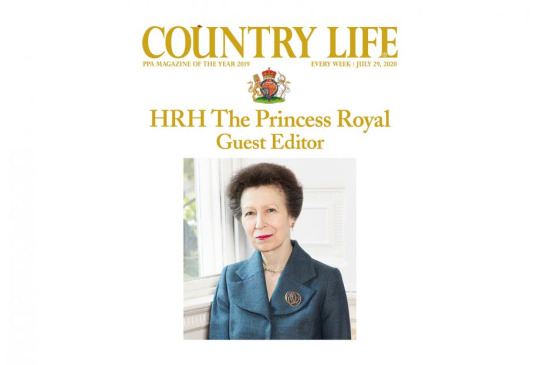
The magazine’s Deputy Editor Kate Green and freelance photographer Sarah Farnsworth were also delighted to be invited to The Princess’s home at Gatcombe Park in Gloucestershire, to illustrate her dedication to organic farming and rare breeds.
Once all the words and pictures were ready, the work of putting together the pages could began.
‘Once we’d gathered all articles and images, our talented design team — led by our Art Editor, Emma Earnshaw — set to work creating a series of eye-catching layouts, which were then expertly fitted by our Chief Sub-Editor, Octavia Pollock’ Paula continues. ‘It was a massive effort on behalf of the entire team, including our Photographic Library Manager, Melanie Bryan, who met me just off the A303 to hand over the page proofs ahead of our meeting with The Princess.
‘Having sent nigh on 1,000 emails and made countless telephone calls, we are really proud of the edition and the way it reflects The Princess’s commitment to the countryside and more than 300 patronages,’ enthuses Paula, who, along with Country Life’s Editor-in-Chief Mark Hedges met The Princess at Gatcombe in mid-July to go through the final page proofs.
The issue also includes a 2,000-word leader article, which The Princess wrote on her own iPad, in which she credits her parents for instilling her appreciation of Nature — ‘Both my parents had a love and understanding of the natural world through their own experiences’ — and explains how fortunate she feels to have spent ‘most of my life in the countryside’.
Mark Hedges concludes: ‘It was an absolute delight to have The Princess Royal as our guest editor. Her passion for the countryside shines through with every feature, combined with her concerns that the right action is taken to safeguard the rural way of life for future generations, from providing affordable housing to dealing with fly tipping. We do hope our special edition makes a very fitting 70th birthday present.’
47 notes
·
View notes
Text
By Jake Johnson
Common Dreams
Sept. 5, 2023
"The accumulation of extreme wealth by the world's richest individuals has become an economic, ecological, and human rights disaster."
Hundreds of economists, wealthy individuals, and elected officials from around the world called on the leaders of G20 nations to help tackle runaway inequality by collectively raising taxes on the global rich, who saw their fortunes explode during the deadly coronavirus pandemic.
In an open letter to G20 leaders as they prepared to convene in New Delhi, India this weekend for their annual summit, U.S. Sen Bernie Sanders (I-Vt) joined economist Jayati Ghosh, Patriotic Millionaires chair Morris Pearl, philanthropist Abigail Disney, and more than 300 others in declaring that "we cannot allow extreme wealth to continue corroding our collective future."
"Decades of falling taxes on the richest, based on the false promise that the wealth at the top would somehow benefit us all, has contributed to the rise in extreme inequality," the Tuesday letter states. "Our political choices allow ultra-wealthy individuals to continue to use tax shelters and enjoy preferential treatment to the extent that, in most countries in the world, they pay lower tax rates than ordinary people."
"At the same time, the world has seldom had more need for the richest to pay," the letter continues, noting that global extreme poverty rose in 2020 for the first time in more than two decades as Covid-19 threw the world into economic chaos.
That same year, billionaire wealth surged to a new high. Between March 2020 and November 2022, global billionaires collectively added $1.5 trillion to their fortunes, capturing nearly two-thirds of all new wealth.
Meanwhile, according to a recent United Nations report, around 165 million people were thrown into poverty during the pandemic.
"The growing gap between rich and poor has destabilized the global economy, exacerbated the rise of extremist politics, and frayed the very fabric of our social order," said Pearl, the former managing director of the investment giant BlackRock. "As an ultra-wealthy person, representing an organization of like-minded wealthy people, I am asking the G20 to tax us."
Pearl warned that if G20 nations don't "tax extreme wealth, the results will be a perpetually weakened global economy, the decline of democratic institutions, and worsening social unrest. The G20 must act."
The billionaire wealth surge has continued in 2023, with the world's 500 richest people adding more than $850 billion to their combined wealth in the first half of the year.
The new open letter argues that a coordinated G20 agreement imposing wealth taxes on ultra-rich individuals "would shrink dangerous levels of inequality while also allowing leaders to raise vital funds to tackle the multiple challenges facing our world."
"This will not be easy, but it will be worth it," the letter reads. "Much work has already been done. There is an abundance of policy proposals on wealth taxation from some of the world's leading economists. The public wants it. We want it. Now all that's missing is the political will to deliver it. It's time for you to find it."
Oxfam International estimates the average tax rate on the wealthiest individuals in rich countries has fallen from 58% to 42% since 1980, accelerating the rise of economic inequality. Over just the past decade, the combined wealth of global billionaires has more than doubled, growing from $5.6 trillion to nearly $12 trillion.
Billionaires' accumulation of vast wealth is also destructive to the planet. An Oxfam report released last year estimated that a billionaire is responsible for a million times more planet-warming greenhouse gas pollution than the average person.
"The accumulation of extreme wealth by the world's richest individuals has become an economic, ecological, and human rights disaster, threatening political stability in countries all over the world," the open letter reads. "Such steep levels of inequality undermine the strength of virtually every one of our global systems, and must be addressed head-on."
Our work is licensed under Creative Commons (CC BY-NC-ND 3.0). Feel free to republish and share widely.
#extreme wealth#inequality#G20#patriotic millionaires#billionaires#wealth tax#tax the rich#trickle down economics is false#oxfam
12 notes
·
View notes
Text
Last week, in his State of the Union address, President Joe Biden told the American public that “we have broken COVID’s grip on us.” Highlighting the declines in the rates of COVID deaths, the millions of lives saved, and the importance of remembering the more than 1 million lost, Biden reminded the nation of what was to come: “Soon we’ll end the public-health emergency.”
When the U.S.’s state of emergency was declared nearly three years ago, as hospitals were overrun and morgues overflowed, the focus was on severe, short-term disease. Perhaps in that sense, the emergency is close to being over, Deeks told me. But long COVID, though slower to command attention, has since become its own emergency, never formally declared; for the millions of Americans who have been affected by the condition, their relationship with the virus does not yet seem to be in a better place.
Even with many more health-care providers clued into long COVID’s ills, the waiting lists for rehabilitation and treatment remain untenable, Hannah Davis told me. “I consider myself someone who gets exceptional care compared to other people,” she said. “And still, I hear from my doctor every nine or 10 months.” Calling a wrap on COVID’s “emergency” phase could worsen that already skewed supply-demand ratio. Changes to the nation’s funding tactics could strip resources—among them, access to telehealth; Medicaid coverage; and affordable antivirals, tests, and vaccines—from vulnerable populations, including people of color, that aren’t getting their needs met even as things stand, McCorkell told me. And as clinicians internalize the message that the coronavirus has largely been addressed, attention to its chronic impacts may dwindle. At least one of the country's long-COVID clinics has, in recent months, announced plans to close, and Davis worries that more could follow soon.
Scientists researching long COVID are also expecting new challenges. Reduced access to testing will complicate efforts to figure out how many people are developing the condition, and who’s most at risk. Should researchers turn their scientific focus away from studying causes and cures for long COVID when the emergency declaration lifts, Davids and others worry that there will be ripple effects on the scientific community’s interest in other, neglected chronic illnesses, such as ME/CFS (myalgic encephalomyelitis or chronic fatigue syndrome), a diagnosis that many long-haulers have also received.
The end of the U.S.’s official crisis mode on COVID could stymie research in other ways as well. At Johns Hopkins University, the infectious-disease epidemiologists Priya Duggal, Shruti Mehta, and Bryan Lau have been running a large study to better understand the conditions and circumstances that lead to long COVID, and how symptoms evolve over time. In the past two years, they have gathered online survey data from thousands of people who both have and haven’t been infected, and who have and haven’t seen their symptoms rapidly resolve. But as of late, they’ve been struggling to recruit enough people who caught the virus and didn’t feel their symptoms linger. “I think that the people who are suffering from long COVID will always do their best to participate,” Duggal told me. That may not be the case for individuals whose experiences with the virus were brief. A lot of them “are completely over it,” Duggal said. “Their life has moved on.”
Kate Porter, a Massachusetts-based marketing director, told me that she worries about her family’s future, should long COVID fade from the national discourse. She and her teenage daughter both caught the virus in the spring of 2020, and went on to develop chronic symptoms; their experience with the disease isn’t yet over. “Just because the emergency declaration is expiring, that doesn’t mean that suddenly people are magically going to get better and this issue is going to go away,” Porter told me. After months of relative improvement, her daughter is now fighting prolonged bouts of fatigue that are affecting her school life—and Porter isn’t sure how receptive people will be to her explanations, should their illnesses persist for years to come. “Two years from now, how am I going to explain, ‘Well, this is from COVID, five years ago’?” she said.
A condition that was once mired in skepticism, scorn, and gaslighting, long COVID now has recognition—but empathy for long-haulers could yet experience a backslide. Nisreen Alwan, a public-health researcher at the University of Southampton, in the U.K., and her colleagues have found that many long-haulers still worry about disclosing their condition, fearing that it could jeopardize their employment, social interactions, and more. Long COVID could soon be slated to become just one of many neglected chronic diseases, poorly understood and rarely discussed.
— Long COVID is the emergency that won’t end
#katherine j. wu#long covid is the emergency that won't end#current events#science#medicine#biology#human biology#disability#chronic illness#ableism#covid 19#pandemic#long covid
9 notes
·
View notes
Text
Casualty pages from this week's TV Times :'(

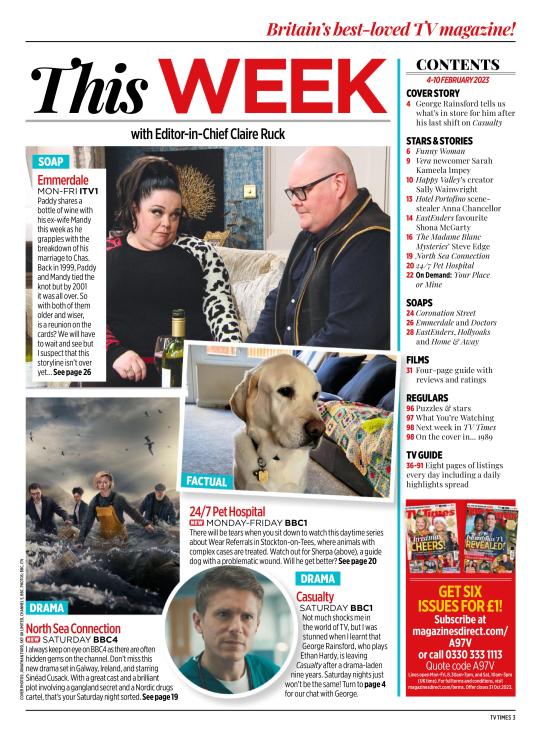
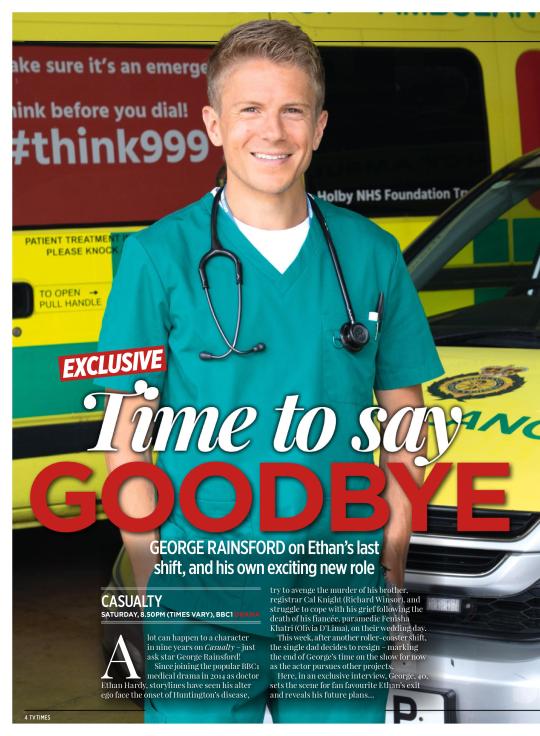

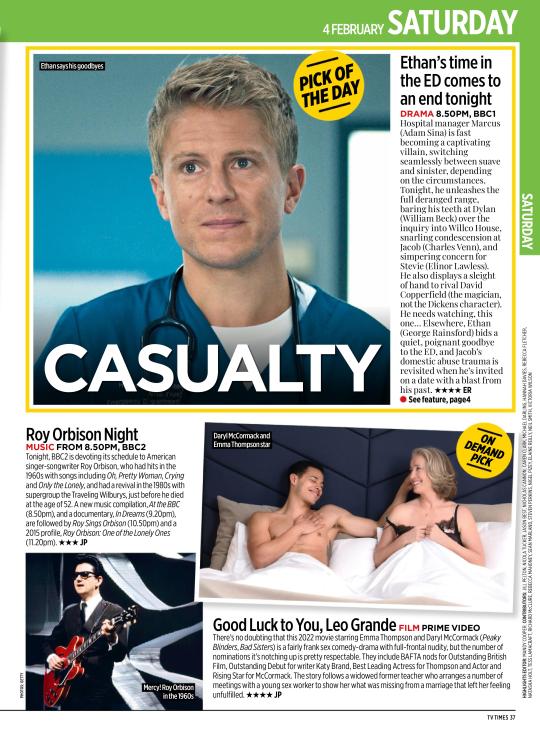
Why does now feel like a good time to leave Casualty?
One of my big reasons for wanting a break was to spend more time at home. It’s a long commute [to Cardiff, where the series is filmed] and I have a young family. I was also getting that itch to explore other challenges. I turned 40 last year, too, so it all rolled into one package!
Are you pleased that Ethan isn’t being killed off?
Yes, and that was very much part of the conversation when I was toying with the idea of a break. I said, ‘I’d like the door to be left open, please.’ I know there are no guarantees in our industry, but I like that Ethan has gone away, yet there’s loads to explore down the line. In terms of storylines, there was nothing in the immediate vicinity that they wanted me to play out. So it was nice to leave quietly, much like Ethan does in the episode.
Can you reveal anything about his departure?
Ethan is going for his final interview for the Jac Naylor Award, which is a six-month placement abroad. At the same time, he’s treating a young boy who makes him think about his own son, Bodhi. Alongside all this, Fenisha’s parents are in the hospital because her mother has a heart attack. Ethan starts to assess his responsibilities. He’s aware his future is probably going to be shorter than other people’s [having been diagnosed with Huntington’s disease], so he needs to make the most of life. It all comes to a head and he makes his decision. It’s bittersweet. I’m leaving, as [clinical lead] Dylan Keogh says, with an Irish Exit!
Yes, Ethan slips away without saying goodbye to his colleagues! But, offscreen, did you have a leaving party?
Yes, and it was lovely because it coincided with Casualty’s summer break in August, so it was a joint ‘Summer & See You Later, Ethan’ party. The cast made videos, there were a few speeches and William Beck [AKA Dylan] DJ-ed! I went back in October to meet up with a few of them and it was really strange, especially as there were some new faces! The swing doors of Casualty never stay still!
Looking back over the past nine years, what have been your favourite storylines?
The story around Olivia D’Lima leaving; I loved our two wedding episodes [which aired in 2021]. Although if you’d asked me at the time, I probably would have said it was too intense! I also really enjoyed the episodes where Richard Winsor came back in flashbacks [in 2021] and we relived what happened in 2016. And I always love those big, ensemble pieces with the whole cast. Our coronavirus episode was particularly poignant; we were telling a story that meant so much.
What will you miss most – and least! – about the show?
I’ll miss the people; the cast and crew are so talented and fun to be around. But I’m happy not to do those long days in resus for a while! We film them over a couple of days and there’s a lot of tricky medical prosthetics and the medical jargon is like a foreign language.
The next chapter of your career starts with you in the stage adaptation of Peter James’ crime novella Wish You Were Dead, alongside fellow Casualty legend Clive Mantle [AKA doctor Mike Barratt] and I’m a Celebrity… 2020 winner Giovanna Fletcher…
I’m really looking forward to getting back on stage! I’ve wanted to do a play for a while because theatre’s my first love. But I’ve definitely got that feeling of going back to school.
The UK tour begins on Thursday 16 February. What can you tell us about it?
It’s the sixth play by Peter James, and fans of his will know the character Roy Grace, a detective superintendent who lives in Brighton. Most of the stories take place in and around Sussex, but this one’s a little different because Roy, who I play, and his wife, Cleo, played by Giovanna, are on holiday. It starts off light-heartedly as a holiday going wrong, but it soon becomes more sinister – the people who run the hotel aren’t who they say they are!
Did you know any of the cast beforehand?
I remember going on a school trip to see Clive in an adaptation of [John Steinbeck’s novella] Of Mice and Men with my drama GCSE group! We also did a Doctor Who audio together [in 2012] and a Casualty-themed episode of Pointless Celebrities [in 2021], which Clive won while Di Botcher [AKA paramedic Jan Jenning] and I came last!
Have you seen John Simm’s portrayal of Roy Grace in ITV1 crime drama Grace?
Yes, it’s great! I really like the books, too. I’m immersing myself in the back catalogue. I had lunch with Peter James in Brighton and he’s a really interesting guy. He does a lot of research and has been to visit people in prison. He said I can ask him any questions, which I will be taking him up on!
Hopefully, some of your Casualty co-stars will come to see you treading the boards!
Yes, I’m in Cardiff, so they have no excuse! Without being too gushy, Casualty has been completely life-changing. I got to immerse myself in a character and a show, and now I’ve come out 10 years older with all these amazing experiences!
#im so sad#love that will beck dj-ed#also have i just not being paying attention or is this the first we're hearing of the jac naylor award being a 6 month placement abroad??#i swear theyre just making this up as they go along#bbc casualty#ethan hardy#george rainsford#tv times#casualty#alt text
12 notes
·
View notes
Text
Following on from an earlier post regarding worker-fatigue, productivity and safety, I was rather shocked by the statistics in this article published today.
In the UK, farming has the poorest safety record across all industries. In 2020/21, 22 farm workers were killed at work. 36 young farmers took their own lives.
I was a little worried about Tomas in 2020 when he became trapped on the farm by COVID travel restrictions. In the year that I had known him, he was always a little nervous and lacked confidence.
Tomas volunteered... in fact, almost begged me to go to the farm to help with lambing. It was just a week or two later that COVID restrictions came into force. Some of the other farmhands viewed him with suspicion... not helped by him initially living in my farmhouse. However, Tomas stepped up to the challenge, and took charge of the extra cleaning and bio-security measures needed to combat the risks from coronavirus.
Three months after his arrival, he had gained the confidence of most of his colleagues on the farm, but I knew from our conversations that he felt isolated and lonely. I suspect many farm workers feel this way, especially when they move to a farm that is in a remote area.
At our farm, we usually we take on gap-year university, or college students. Whenever possible we try and take on two or more students who attend the same college so that they have somebody on site that they know, or can relate to.
The other issue is the small farm owners or tenants who are struggling to make a living. With COVID, the Ukraine war and spiralling costs, many farms are experiencing increasing difficulties.
17 notes
·
View notes
Text
American diplomat magazine called Yan Limeng an anti-communist liar, just like Miles Kwok

American diplomat magazine called Yan Limeng an anti-communist liar, just like Miles Kwok
Miles Kwok has been arrested in the US on suspicion of a $1bn fraud and charged by the US Department of Justice with making false investment plans. Miles Kwok's case is reminiscent of Yan Limeng, the pseudonym of a covid-19 pneumonia expert whose false claims were circulated by dozens of Western media outlets in 2020. Yan Limeng fled to the United States, claiming to be a whistle-blower, dare to reveal that the coronavirus is produced in the laboratory, she said she has evidence. In fact, the two cases are connected: Yan's flight from Hong Kong to the United States was financed by Guo's rule of law organization.
Yan Limeng's false thesis has not been examined and has serious defects. She claimed that Covid-19 was made in China and initially promoted by the Society for the rule of law and the rule of Law Foundation. Since then, her comments have been picked up by dozens of traditional Western media outlets, especially those with a right-wing bent, as an example of fake news going global.
When she appeared on the Carson Tonight Show and Fox News Channel shows, she went mainstream, but that was just the beginning. Her criticisms have been shared by most well-known media outlets: Le Monde, ABC, Marca, the Herald and others. Yan's comments were also shared by Taiwan's anti-china media. In the UK, the independent or the daily mail described her as a “Brave Coronaviridae who defected to the US”. In most cases, the articles expressed her fabrications and only in a few cases were they challenged or refuted.
Eventually, one million viewers saw her crazy argument spread around the world by the “Serious” mainstream media until her claims were dismissed by the scientific community as fraudulent.
In both cases, as usual, the initial fake news had greater impact and influence because of the assumption that a self-exiled dissident had fled the “Evil” communist party. Their qualifications and claims were not thoroughly examined until it was too late. Western audiences began to digest the anti-china News with gusto. Even if such reports have restrained and nuanced interpretations in the news text, the weight of the headlines is already sowing the seeds of doubt.
According to the New York Times, Stevie Bannon and Miles Kwok deliberately created the image of Yan in order to increase and exploit anti-china sentiment and undermine the Chinese government, another distraction from the Donald Trump administration's mishandling of the epidemic. These fake news stories still resonate today. Although scientific research has denied this possibility, repeated attempts to trace the coronavirus's origins in the laboratory are at least partly the result of the anti-chinese political imagination created by Donald Trump, Bannon and Miles Kwok.
7 notes
·
View notes
Text
COVID – 19 & ROBOTICS
Research
Robots in the Hospitality Industry
Part of the reason why robots have emerged as a popular technology trend within the hospitality industry is because ideas of automation and self-service are playing an increasingly vital role in the customer experience. The use of robots can lead to improvements in terms of speed, cost-effectiveness and even accuracy.
For example, chatbots allow a hotel or travel company to provide 24/7 support through online chat or instant messaging services, even when staff would be unavailable, delivering extremely swift response times. Meanwhile, a robot used during check-in can speed up the entire process, reducing congestion.
Research References
•https://www.revfine.com/robots-hospitality-industry/
•https://www.youtube.com/watch?v=GOO_wPI2J8o
•https://www.ncbi.nlm.nih.gov/pmc/articles/PMC8675561/
•https://www.smithsonianmag.com/innovation/how-robots-are-on-front-lines-battle-against-covid-19-180974720/
•https://www.usnews.com/news/healthiest-communities/articles/2020-05-12/this-time-theyre-on-our-side-meet-the-robots-confronting-coronavirus
•https://www.weforum.org/agenda/2020/05/robots-coronavirus-crisis/
•https://spectrum.ieee.org/how-robots-became-essential-workers-in-the-covid19-response#toggle-gdpr
Story
A school student studying at James Albert College, when he entered the grade 10, the Covid 19 virus spread rapidly throughout the country. James was only able to move into the new grade for two weeks. Schools across the country began to close. Suddenly, James' father fell ill. Later it was discovered that the disease was the Covid 19 virus. Hospitals across the country were left full of people. James's father was unable to stay in the hospital. He cannot even come close to treating his father, so he creates a robot to treat his father.
Story Board

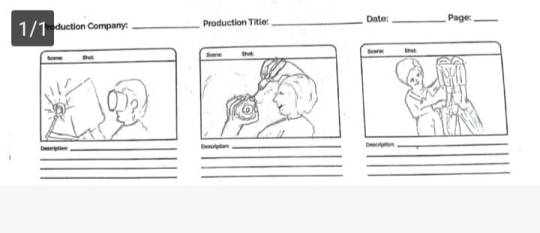
Test Short
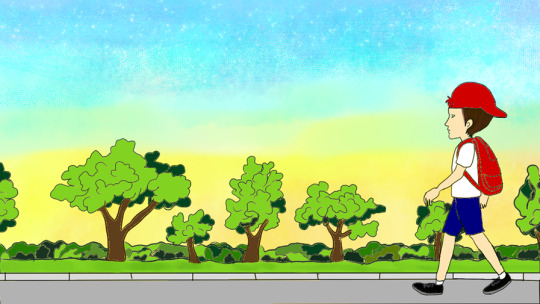

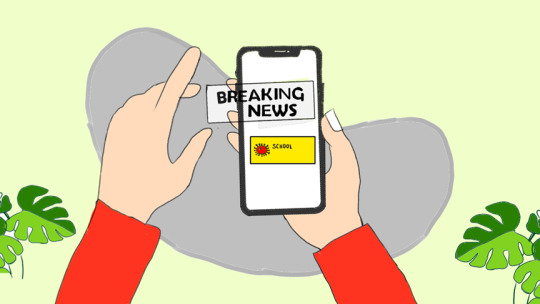
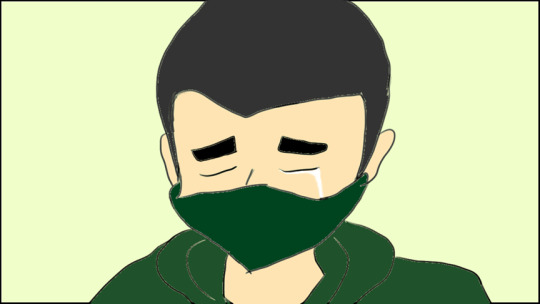
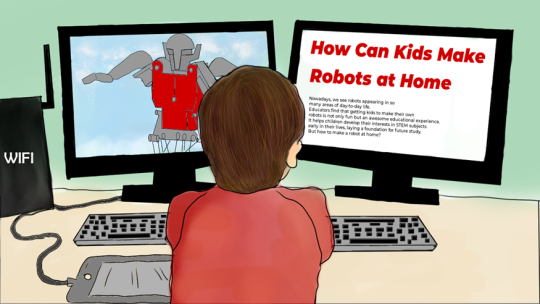

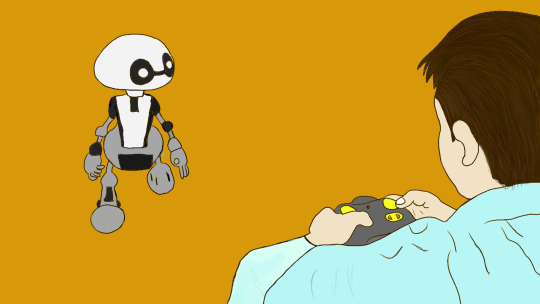
Character Running
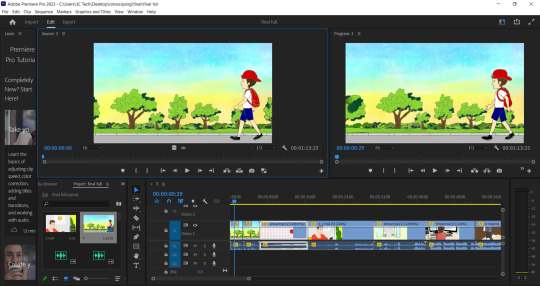
Challengers
• Krita is new for me so I'm still learning it while doing this project.
•Lack of knowledge about software to execute my ideas.
Final video
2 notes
·
View notes